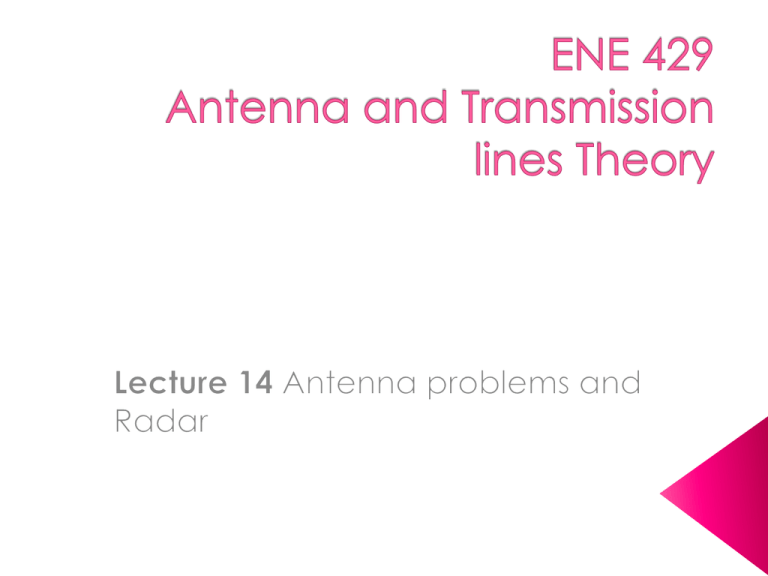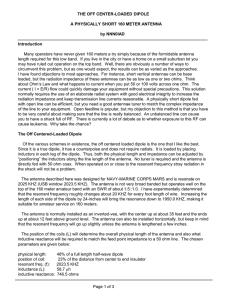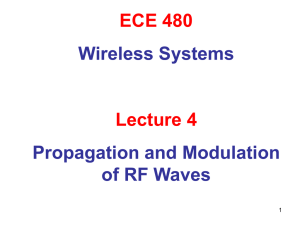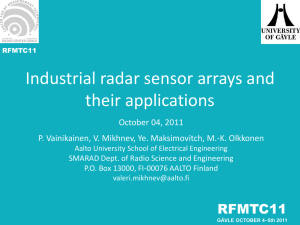10 - web page for staff
advertisement

Small loop antenna (magnetic dipole) Dipole antenna generates high radiation resistance and efficiency For far field region, l l cos( cos ) cos( ) I0 e 2 2 a H j 2 r sin F ( ) 15I 02 P(r , ) F ( )a r , Pn ( ) 2 F ( ) max r 2 where l l cos( cos ) cos( ) 2 2 F ( ) sin j r Half-wave dipole 2 cos ( cos ) F ( ) 2 Pn ( ) F ( ) max sin 2 p = 7.658, Dmax = 1.64, Rrad = 73.2 Image theory is employed to build a quarter-wave monopole antenna. 4 5 Monopole antenna is excited by a current source at its base. Directivity is doubled and radiation resistance is half of that of dipole antenna. 6 The best operation: ground is highly conductive (or use counterpoise in case of remote antenna) Shorter than /4 antenna arises highly capacitive input impedances, thus efficiency decreases. Solution: inductive coil or top-hat capacitor Inductive coil Top-hat capacitor 7 A group of several antenna elements in various configurations (straight lines, circles, triangles, etc.) with proper amplitude and phase relations, main beam direction can be controlled. Improvement of the radiation characteristic can be done over a single-element antenna (broad beam, low directivity) 8 To simplify, 1. All antennas are identical. 2. Current amplitude is the same. 3. The radiation pattern lies in x-y plane Il0 e j r E0 j sin a , From 4 r Il0 e j r a . Consider , E 0 j 4 r 2 9 E tot I1l0 e j r1 I 2l0 e j r2 j a j a 4 r1 4 r2 Let I1 = I0, I2 = I0ej, since r1 and r2 >> d/2 for far field, we can assume 1 2 and r1 r2 r. 10 But the exponential terms cannot be approximated, then d r1 r cos 2 d r2 r cos 2 E tot I 0l e j r j0 4 r 0 2 I 02l 2 P( r , ) 32 2 r 2 j2 d 2 e cos( cos ) a 2 2 2 d 4cos ( 2 cos 2 ) a r 11 We can write this as P(r, 2 , ) F unit Farray ar Funit = a unit factor or the maximum time-averaged power density for an individual element at 2 Farray = array factor = 4cos2 ( ) 2 where d cos . This depends only on distance d and relative current phase, . We can conclude that the pattern function of an array of identical elements is described by the product of the element factor and the array factor. 12 We will simplify assumptions as follows: 1. The array is linear, evenly spaced along the line. 2. The array is uniform, driven by the same magnitude current source with constant phase difference between adjacent elements. I1 I0 , I 2 I0e j , I3 I0e j 2 , I 4 I0e j 3 ,...I N I 0e j ( N 1) E tot I 0l e j r j0 (1 e j e j 2 ... e j ( N 1) )a 4 r 2 N sin ( ) 2 F array 2 sin ( ) 2 (Farray)max = N2 13 Yagiuda (rooftop antenna) Parasitic elements are indirectly driven by current induced in them from the driven element. 14 Consider power transmission relation between transmitting and receiving antennas where particular antennas are aligned with same polarization. Let Prad1 be Ptotal radiated by antenna 1 have a directivity Dmax1, Prad 1 P1 (r , , ) Dmax1 2 4 r Prec 2 Prad 1 P1 (r , , ) A2 Dmax1 A2 . 2 4 r Prad 2 Dmax 2 A1. With reciprocal property, Prec1 P2 (r , , ) A1 2 4 r Dmax1 Dmax 2 Therefore, we have . A1 A2 15 Each variable is independent of one another, so each term has to be constant, we found that Dmax1 Dmax 2 4 2. A1 A2 16 Effective area (Ae) is much larger than the physical cross section. Prec 2 Ae 2 P1 (r , , ) More general expressions Prad Prec Dt ( , ) Ar ( , ) 2 4 r We can also write Prec Dt ( , ) Dr ( , ) . Prad 4 r 2 17 Finally, consider Prad = etPin, Pout = erPrec, and Gt = etDt, Gr = erDr Pout Gt ( , )Gr ( , ) . Pin 4 r 2 Friis transmission equation Note: Assume - matched impedance condition between the transmitter circuitry/antenna and receiver - antenna polarizations are the same. 18 Additional impedance matching network improves receiver performances Zin Zant Voc2 Voc2 Prec 2( Z ant Zin ) 4 Rrad 19 Since the receiver is matched, half the received power is dissipated in the load, therefore VL2 1 Prec 2 2 ZL Without the matching network, ZL VL V . Z L Z ant oc 20 A monostatic radar system Some of energy is scattered by target so called ‘the echo signal’ received at the radar antenna. Let Prad be the radiated power transmitted by the radar antenna, then the radiated power density P1(r, , ) at the target at the distance r away is Prad 1 P1 (r , , ) D( , ) 2 4 r The power scattered by the target is then Prad 2 s P1 (r, , ) s = radar cross section (m2) This scattered power results in a radiated power density at the radar antenna of P2 (r , , ) Then Prad 2 Prad 1 D( , ) s 2 2 2 4 r (4 r ) Prec1 P2 (r, , ) Ae . By manipulation of these equations, we have Prec1 s 2 2 D ( , ) Prad 1 4 3 r 4 or Prec1 s 2 A e. 4 2 Prad 1 4 r Radiation patterns for dipole antenna http://www.amanogawa.com/archive/DipoleAnt/DipoleAnt-2.html Ex1 Suppose a 0.5 dipole transmitting antenna’s power source is 12-V amplitude voltage in series with a 25 source resistance as shown. What is the total power radiated from the antenna with and without an insertion of a matching network? 0.5





